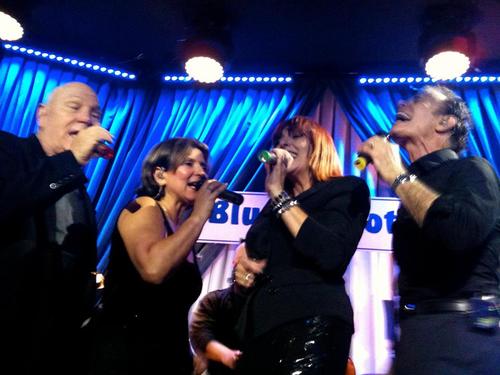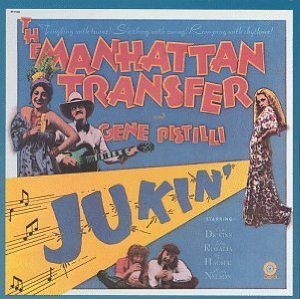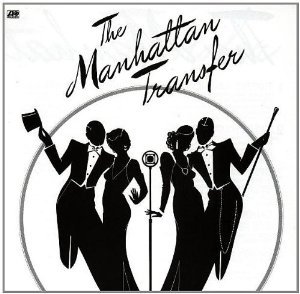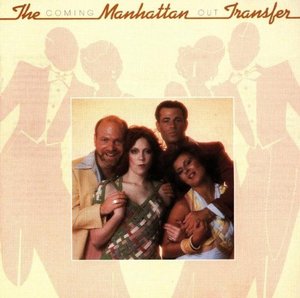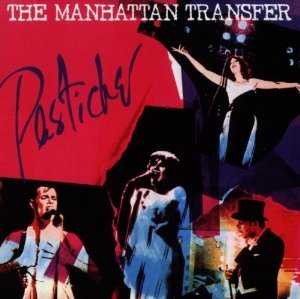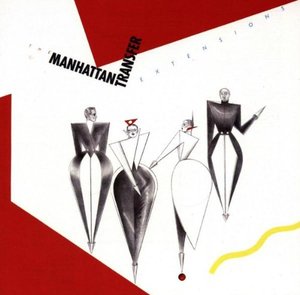A Conversation with The Manhattan Transfer's Tim Hauser, Janis Siegel, Alan Paul & Cheryl Bentyne
Mike Ragogna: Tim, you originally were in The Criterions with your childhood pal Tommy West, who went on to produce Jim Croce and Anne Murray and was part of the folk-rock group Cashman, Pistilli & West.
Tim Hauser: Yes, Tommy and I had a wonderful relationship sharing music that we both loved very, very much. When I discovered rhythm and blues, Tommy was the first person that I met that had as much of a passion for it as I did. Lo and behold, he was a musician, he played the piano and played the guitar and he wrote arrangements, so it was ideal. We started a vocal group and we had this wonderful experience together.
MR: How did The Criterions' get its record deal?
TH: We went around knocking on doors of record companies, that's what we always used to do. We met one producer, Al Brown, in an elevator. The stuff we made with him didn't come out at the time; we couldn't get a deal. Then about eight months later, either my father or Jimmy Ruff's father--Jimmy Ruff was a member of the group--knew this songwriter in New York who was trying to get this song that he'd written out and he had partnered up with this sound engineer for ABC radio who happened to be Alan Freed's engineer. He started this label called Cecilia and he liked the way we sounded, so he signed us to record his friends' song. It certainly got good promo with Alan Freed on the radio, and that's how our first record came out. That was a great experience.
MR: Alan, what got you into music?
Alan Paul: My history actually started with Broadway. I was in the original Broadway cast of Oliver! when I was twelve with Clive Revill and Georgia Brown and Davy Jones. So that's kind of where I started, I was an actor in New York. Before that I started singing Vaudeville music, I studied with this guy, Charlie Lowe in New York who had a studio at 1650 Broadway, down in a basement. It was actually Milton Berle's building, which I found out years later. Tim and I went to lunch once with Uncle Milty and he was saying that.
So when I was a kid, I studied there, but everybody studied there. Elliott Gould, Dustin Hoffman, Christopher Walken [does impression] was there for a while! But anyway, that's kind of where I started. After I graduated from high school I studied voice--classical, actually--for four years and I sang up in the Catskill Mountains as an MC/activities director at this grade "C" hotel where Saturday night's second show would always have a stripper, which, for me, was fabulous since I was a nineteen year old guy. "Okay, ladies and gentlemen, please welcome Princess Suzanne!" So it was a great education. Then when I got out of college, I went back into business and I was in the original Broadway cast of Grease, which actually started off-Broadway and then after six months moved up to Broadway.
MR: So which character did you play?
AP: I was Johnny Casino, Teen Angel, which was great for me because I didn't make my appearance until the second act, which means I would come and I would sign in and then I'd leave and go do my own thing and then they'd be schvitzing, wondering where I was and then I'd show up and swing in on a rope just in time to do my "Beauty School Drop Out." Barry Bostwick was in that, and Adrienne Barbeau. It was in that show that I met our ex-partner Laurel Massé, who was dating the drummer of the show, and the rest is history.
MR: Janis, your turn. What's your background?
Janis Siegel: My background was AM radio, really, in New York City in the late fifties, early sixties. It was a very broad spectrum of music we listened to. The radio was on constantly in the house, but other than that, my parents were not serious music lovers. We eventually got a phonograph. The first single I bought was "Tequila" by The Champs, then "Lollipop" by The Chordettes. I loved the harmony in that. But there were certain records that just completely influenced me that I came upon by accident. I was into folk music and writing my own songs. I had a group when I was twelve, Young Generation, and we made singles. Our producer was Richard Perry, whose office was in 1650 Broadway. Richard had two clients at that time--us and Tiny Tim. Somewhere there is a yellowing photograph of three twelve-year old girls and Tiny Tim holding his ukulele. He used to carry it around in a paper bag. He was a true freak. The first true freak I ever met with a long line of freaks to come.
TH: Because it wasn't contrived.
JS: No, it was the real thing. But my musical background really was pop music and maybe Broadway. Because I lived in Brooklyn, we went to the theater fairly regularly to see musicals.
MR: Cheryl, you're up!
Cheryl Bentyne: My family was musical. My father was a Dixieland clarinet player and my mother, when I was very young, she was in a trio that sang two songs with the band my dad was in. They had taffeta skirts and little velvet tops. It was fabulous. They did "Dream" and a couple other songs, so there was always Dixieland jazz in the house. They would be rehearsing and I would go, "Ugh, old people music!" But the truth is I didn't really listen to anything else. We had radio, of course, and I watched The Ed Sullivan Show. My influence, since I was in a very small town in Washington, was television. I was glued to those shows--The Entertainers, Hollywood Palace, The Judy Garland Show--I was just glued to them. And movies! So basically, my experience getting on the stage and singing was in my dad's band. I was in plays in high school, musicals. When I was a freshman in high school, my mother saw me do this song from Funny Girl and she said, "I didn't know you could sing! Why don't you go sing with your dad's band?" I said, "Well, okay." They paid me twenty-five dollars a week. I thought that was amazing, so I did that all through high school. So that was my introduction, and it was a good one.
MR: Tim, you came up with the concept of The Manhattan Transfer. How did that start?
TH: I had a group previous to this one also called The Manhattan Transfer, and we were doing sort of folk rock stuff. Tommy and I went to school with Jim Croce as you well know, so we were doing a bunch of Jimmy's stuff because he hadn't "happened" yet, if you will. But there were some other songs. I came up with this idea of doing the doo-wop tune "Guided Missiles" and then Jean Goldkette's "Sunny Disposish," Bix Beiderbecke, and one side of me was going, "What are you doing?" and the other side is just feeling it without question. I noticed the audiences didn't seem to discern. They were just taking it as it came. So when the group split up, I was sitting around my apartment in New York and I noticed I had a collection of stuff that I really thought, "Oh, this would be great, this would be great" and that's when the idea just came across to me. "Why can't you have a vocal group that just does a lot of different styles? Is it written in stone?" But nobody had ever done that before.
MR: Yeah, swing era vocal arrangements, doo-wop with the birth of rock 'n' roll, and you've got R&B and lots of styles that can be absorbed.
TH: People had certainly been exposed to all that kind of stuff on their own. So I thought to myself, "Okay, what are other groups already doing that I couldn't do any better?" and I eliminated those things from the matrix and what was left was that there was no one doing vocalese after Lambert, Hendricks & Ross. Yeah, The Pointer Sisters did a great version of "Salt Peanuts," but doo-wop had gone away and was just starting to come back, and I thought, "Well, that's interesting." Four-part harmony? Nobody was doing four-part harmony. The end of that were the The Hi-Lo's and The Four Freshmen and here we were already into the early seventies and it just didn't seem to be around. But I loved that stuff and I loved the big band incarnation of four-part harmony as well as the Gene Puerling style of four-part harmony that was really quite a departure from that. I like all of it, and nobody was doing any of that stuff anymore, so I thought, "Okay, let's concentrate on that." When I met my partners, they all seemed to like that stuff, too, so I had a collection of things that we started out with. I had Blue Champagne, this Jimmy Dorsey record, "Java Jive," "That Cat Is High" is a 78 I found by The Ink Spots. I collected this stuff. I thought it was really cool. I thought, "Well, that's a good way to start" and that was it.
MR: How did you come across Ahmet Ertegun and Arif Mardin come across you guys?
AP: Well, once we got together we worked for six months on like five songs. I was a member of The Lambs Club in New York, which was kind of an actors' fraternity. So every night after my performance, we'd go over there and rehearse. They gave us a space. That was when we really honed in on our sound. We had certain goals, we needed a manager and we knew we wanted to get a record deal, because we wanted to expand this. So for two and a half years, we schlepped around New York playing the clubs and we did very, very well.
MR: Where did you play?
AP: We played Reno Sweeny's, Kenny's Castaways, Max's Kansas City, but nobody would sign us. Nobody would touch us. I think we had somebody from every major label come down, but we were too unusual, they didn't know what to do with us, they didn't want to take the risk.
JS: The four-part harmony was scary.
AP: But Tim was friends with Bette Midler, and we would see Bette from time to time and we got to the point where we felt that the management team we had just wasn't happening. They weren't able to do what we were hoping, so we hooked up with Bette's manager Aaron Russo. Because Bette was on Atlantic Records, that opened up that door.
JS: So Bette introduced us to Aaron Russo and the first thing Aaron did was throw Ahmet Ertegun into a limousine and drive him to Philly where we were playing at The Bijou Café. We got the call that evening, "Hold the show, I'm bringing Ahmet Ertegun." So we held the show, Ahmet got there, and he signed us that night.
TH: Aaron played our demo tape for him at his office and he loved it. He wanted to sign us sight unseen, but Aaron said, "No, no, you've got to see them in person. It's great that you want to sign them, but you have to see them in person."
MR: Was it because of your history at 1650 that Richard Perry came into the mix?
JS: No, that was coincidental, so it was really kind of freaky to work with him again after having worked with him when I was twelve.
AP: And why we worked with Richard? For the first part of our career, we had a specific look, we had a specific sound, it was very stylized, very nostalgic, and to some people, it was brand new, they had never heard this music before. But after the success of the first album and all the touring, we had a television show on CBS, a summer replacement for Cher. Aaron comes to us and says, "You're going to have to change everything. You have to change your image." We thought he was out of his mind. We said, "What are you talking about? We've spent all these years developing this!" But this was right at the cusp of disco. He said, "What you're doing is like a fad. If you stay doing this thing, then you're going to disappear with it. You need to do a more contemporary record." We didn't know what to do, so that's when he suggested Richard.
TH: With our first album, we got a top twenty hit with "Operator." When Coming Out was released, nothing really happened in the United States, but "Chanson D'Amour" became a massive hit over in Europe and then "Speak Up Mambo" became a hit as well. So that established us in Europe as a significant entity. Then with our third album, Pastiche, I don't think Atlantic really even released it in the United States. They hated it. They didn't hear it at all. They didn't get "Walk In Love." "Walk In Love" was made to be a single.
MR: You also did the Rupert Holmes song, "Who, What, Where, When, Why."
JS: Well, that was with the record company's insistence.
TH: Yeah, they wanted us to do two or three other tunes, because they didn't hear any other hits. But "Walk In Love" became a top twenty record in England. In hindsight, I should've gone to Ahmet, but I didn't. I went to Jerry Greenberg and that's a whole other story. They wouldn't release it, so the album died in the United States. Then right after that, we were getting ready to do a Christmas tour. We were in rehearsals and when we went home one night, Laurel got into an automobile accident in Burbank and she broke her jaw. Her jaw was wired shut, so we couldn't work for like six months, we were just sitting around waiting for her to get better. Then when she got better, we had our first meeting and at the meeting, she decided she wanted to quit. It was like, "Oh, great, we waited around for six months and then she's going to quit." So we said, "What are we going to do? Are we going to stay together?" We took the matter to Ahmet and he said, "Well you should look for somebody else," so we did.
We set out on the path to find a replacement for Laurel. We didn't want to do the cattle call and let everybody know because we thought, "How can we deal with that?" We didn't want every wannabe in town. For me at least, I didn't want to deal with that many people auditioning. Besides, probably half of them couldn't sing anyway. So we were very discreet about who we asked and we had these quiet auditions over at Janice's place in Hollywood. We had certain criteria that we wanted to meet for the collective sound. She would really have to be a part of that sound and make it work, stand out as her own as a soloist, and lastly, be an individual that we could get along with. That last one's very important. We've been together forty-one years, so there's obviously something to that. When Cheryl came in, it hit me right away. As soon as she started singing, I looked over at Al and Al's looking at me, and I know what's going on in his mind by the way he's looking at me, and I'm telling him what's going on in my mind. This is happening. So we all get very excited afterwards and Cheryl didn't understand why we were so excited because we obviously had to meet and talk after she left. But we were excited because we all knew that Cheryl was the one. She certainly seemed to be a nice person with good energy. It was quite an experience how it happened.
CB: I had the advantage because I knew them, they didn't know me. I knew the group, I knew the sound, I grew up with that kind of music, but I never sang with other voices. I think there was a built-in understanding of phrasing and of sound and luckily, the sound worked. It could not have. I could have opened up my mouth and did, "Candy" and it could've been really awful, but I didn't. It was a dream. It was in the afternoon, I came over and knocked on the door and Janis said, "I'm Janis Siegel" and I said, "I know! I know who you are." Then I walked into the room with these people and sat at the piano with them. Somebody else was taking the reins at that point.
MR: And now you're getting into the period where it's more electronic and you're having to transition again.
TH: Well, the sound was the producer's input.
MR: Right, it wasn't like you were sitting down and saying, "We're going to have to use this," but were they pushing you into a more contemporary approach?
TH: No, Atlantic was really cool with that.
JS: We pretty much went there ourselves.
CB: Was "Birdland" the recording you played for them? It was obviously pretty new. Was that what got them all worked up?
JS: That was the cornerstone of our presentation, but we must've played other things.
AP: We were at another juncture, though. We were very frustrated that, with all the success we had in Europe, we couldn't break America. We just weren't getting played on the radio even though we had a television show. Back then it was like either or. If you're on TV, you don't get played on the radio, and when we did the television show, we were petrified of that. In 1979, we were already listening to a lot of other music, a lot of different stuff. We were introduced to Jay Graydon through our sax player Don Roberts. Jay was known mostly as a studio musician in LA. He was like the top a-list for studio players for guitar. But he was also partners with David Foster and he was very much into producing and everything else. So we went over to his studio--his house--the studio was in the bedroom next to the bathroom where he slept.
MR: Right, these were the days when everybody's studio was in their house.
AP: Or in the garage. We did all of Extensions in his garage. Literally, his garage that was full of boxes and crap. He played us some stuff that he and David had done. I remember for me he played "Nothing You Can Do About It." I heard that and to me, it was just so modern and so amazing, I said, "This is fantastic. This would be great!" It seemed like a perfect match and that was it. We decided after we met with him, that was it, let's take this plunge and do this.
MR: I already asked Janis and Cheryl this question in a previous interview, so Alan and Tim, what's your advice for new artists?
AP: Follow your heart. Follow your heart, take risks and know the business. Know what you're doing ahead of time, because today, you've got to be a business man in order to make it.
TH: Yeah, I think more of my son than myself because my son is in the business now. He just got a mention from Billboard. He's with Datsik. They have a single out called "Closer To The Sun." It's great. It's really good. I don't say that about everything he does, but oh man. I watch him, since I'm from a different time, but Basie and I sit down and really discuss the differences. He says, "See, you do one thing, because back in your time, you could get away with doing one thing. You can't do one thing anymore." He makes records under different names, he's got his own stuff, he partners up with Datsik, who's already a top guy, and each partnership is a different entity. Then he also works on the business side. He's got his hands in a lot of different pies, but that's how he makes it work, and he's making it work.
MR: Would you suggest that to others as well?
TH: He's making it work, so if somebody said they wanted to get started and said, "What should I do?" I say, "Talk to my son." He certainly knows more about it. His daughter is in the business, too. It's a different time. Personally, I don't envy them. I think it was an easier time for us when we were coming up.
To Be Continued...
[Note: Janis Siegel will be returning to Chicago's City Winery on January 12th.]
Transcribed By Galen Hawthorne
A Conversation with SmoothJazz.com's Sandy Shore & Donna Phillips
Mike Ragogna: It's official. Smooth Jazz is in the top five formats on the internet. You must be pretty excited about its current status.
Sandy Shore: We have never given up on the idea that this music mix would be well received globally. At least the way we present it, the format is really the best of the best from contemporary jazz, pop, funk, chillout/lounge, jazz, soul, neo-soul, world music and even elements of hip hop. The "Smooth Jazz" music mix is predominantly instrumental, only accented by vocals and therefore crosses language barriers with ease, which obviously makes appealing on an international level. And most importantly, the sonic groove feels good and again, when done right, speaks to all age groups.
Donna Phillips: In fact, our age demo on both our site and social media platforms defies that of the past over-consulted FM radio models, proven with the introduction of many new Smooth Jazz acts in their late teens and twenties who have seen great acceptance by audiences worldwide.
SS: So yeah, I'm thrilled that the world embraces Smooth Jazz, but definitely not surprised. I was counting on it! [laughs]
MR: Now that Smooth Jazz has evolved into something beyond its stereotype of light and breezy, how has your online station adapted to the change?
SS: At the risk of not sounding humble, we believe that we helped destroy this stereotype. We've been Redefining "Smooth Jazz" since the beginning of SmoothJazz.com in 2000 and in many states in the US and countries around the world, defining the format, so there's no need to adapt to the change we set in motion nearly 15 years ago. And for me, way before that when I was programming the format in Monterey, California, on KXDC, we called the station "Radio Pacific" and played music that some would never have imagined blended together. We also have brought back album-oriented radio. With our World Premiers of new music from format legends, we literally play the albums all the way through the weekend before they're released and the artist sits in the studio and takes the listener track-by-track of why they included each and every song. We've had the privilege of doing this with George Benson, Al Jarreau, Boney James, Dave Koz, Keiko Matsui and many more. In the new year, Dianne Reeves.
DP: Due to our independently owned and operated status with SmoothJazz.com, we've been able to create from an instinctual place focusing on relevant new ways to connect the audience not only with the music, but the artists behind the music as well as the many unique live event opportunities to experience the music. This more open experimental approach has proven successful in creating a more sustainable sales model for the record labels and more impactful and lasting branding model for rising star artists. By remaining more open and inclusive, the future appears endless with possibility for this diverse music genre as artists and festivals are encouraged to reach beyond previous limitations for creating and presenting new music. SmoothJazz.com's slogan is "Nu Jazz No Rules" for the very reason that labels and boxes destroy all living things.
MR: [laugh] Nice. What are the origins of SmoothJazz.com?
SS: I purchased the domain name in 1995 when I was 31 years-old and on the air as a DJ at several California radio stations doing my best to make a living. The $100 required to purchase the name was earmarked for my electricity bill. [laughs] But I was becoming more and more disenfranchised with terrestrial radio, the narrowing of broadcasting, the over-consulting of the music and the longer commercial sets. I knew if there was ever an opportunity to break off from FM and get radio back to an artful medium, the internet was going to be the way. Keep in mind, this was before streaming existed. It would take seven minutes to download 45-seconds of audio back then. I have no idea why I believed so strongly in the future of Internet media, but it was so palpable to me, even then. Maybe because I wanted it so badly, as a listener and a consumer, I knew that the internet would bring deeper dimensions to the limited audio world of radio with visuals and colors and eventually video.
When I met my now business partner of 18 years, Donna Phillips, she put the color into the ideas. Her graphic design degree and willingness to learn how to move the visual experience online, combined with my insatiable desire to broadcast a deep mix of music globally, is the foundation for SmoothJazz.com. We originally used SmoothJazz.com for selling concert tickets for our '90s Monterey Bay concert productions. Without secure shopping back then, our customers would literally have to print out the order form and mail it in with a check. We are fortunate enough to be within close proximity to the Silicon Valley and many kind-hearted individuals who seemed to overlook our lack of tech savvy, but really bought into our dream of broadcasting around the world. We were told to build our ideas and music library three years before the technology was even available, so we did.
We were grandfathered into the exciting project of "Net Radio" by AOL/Shoutcast, Winamp, Real Audio and our friends at Apple were more than generous with us at the founding of iTunes. I can remember when Steve Jobs' assistant called me to make sure we were happy with our partnership. In addition to Donna, I brought in Scott O'Brien, who I worked with when he was programming a radio station in Monterey, California. Scott's programming has always been clever and sophisticated. Even back in the '70s and '80s, he featured a progressive mix of music from Pat Metheny to James Taylor. Now based out of Seattle, he's still at the helm of our music programming of SmoothJazz.com.
MR: By the way, what originally got you into radio?
SS: I knew at 8 years old, I was supposed to be in radio. There was no question about it! I was obsessed with the medium, didn't go anywhere without my transistor radio. By the time I was 14, I took a Radio & Television course in school and my instructor, who would become my first boss and lifelong mentor, Nicolas Souza, tried to convince me to get into TV. MTV had just debuted and he felt strongly that the future for radio was television. I refused and he hired me at the local AM station on Cannery Row, not because I was any good, but because I wouldn't take no for an answer, and I started broadcasting at 15. I was on the air in Los Angeles by the time I was 22. Women were not really IN radio in the '70s and early '80s. In fact, I was told by one program director that I would never be on the air full time during the day time as women were only used for evenings and weekends. Maybe I should have thought twice before taking a job at KMEN.
MR: Good for you, Sandy. Are there any artists that you feel are the flagbearers for the format?
SS: Oh God, yes, and they come from different corners of the recording industry. The sound really started taking shape with artists like Bob James, Earl Klugh, David Sanborn, Larry Carlton, Spyro Gyra, Chuck Mangione, Joe Sample, George Benson, Al Jarraeau... But before their records, there were artists like Wes Montgomery and Stan Getz whose laid-back style of jazz was really mellow--or "smooth"--and started a trend of relaxing jazz. Then there was the whole fusion jazz contingency with the likes of Herbie Hancock, Yellowjackets, Pat Metheny, Chick Corea, Jeff Lorber, Stanley Clarke/George Duke, many of whom are still kicking ass today and being rightfully acknowledged for their cutting edge, out of the box artistry. Crossover vocal acts like Anita Baker, Sade, and Simply Red also helped shape the sound of Smooth Jazz back in the day and they became the over-played cornerstone vocalists in the format. Not sure if that helped or hindered their careers, since they were the ones thrown under the bus along with Kenny G when the format became so watered down by certain industry consultants. Plus, the merging of artful, "new age" musicians in the '80s like Michael Hedges, Mark Isham, Michael Manring that the Windham Hill label promoted were also integrated into the original sonic environment of the first Smooth Jazz radio stations. The format was called NAC back then--New Adult Contemporary. But the true, in the pocket, Smooth Jazz flag bearers? That category would have to include Rick Braun, Jeff Golub, Peter White, Richard Elliot, Jonathan Butler, Dave Koz, Acoustic Alchemy, Fourplay, Boney James, and the like at the top of the list.
MR: What is the demo for Smooth Jazz these days?
SS: For us, with an international audience, our demo skews a little younger and a little more male. Our sound incorporates a lot of fresh music with the goal to keep us sounding contemporary and relevant. We're seeing the demo age peak between 25-54 as the strongest with a 60/40 split of men/women. Here is the Top 10 on Facebook: US, Italy, Brazil, Mexico, Japan, Germany, UK, Ireland, Spain, and the Philippines
MR: What's your favorite recording artist of all time and why?
SS: You do know that's a very hard question for a radio person? But I know the answer, and I know it because in 2005, I almost lost my mom. She was in critical care for nearly a month and there was only one artist's music I could listen to and thank God he has many soulful albums to chose from. Van Morrison. I always say he's tapped into a higher source...
MR: Does SmoothJazz.com embrace new artists and how does it do that?
SS: Absolutely! We've built our entire platform around new artists and new music. Nothing makes me feel better about life than discovering new music. That is exactly why I got into radio. My passion for music. Until SmoothJazz.com, there was not a global marketplace for the artists of any format! We created an online environment where the songs we played "on the air" would display the album cover for the duration of the song on our website with links to buy on-line. Back in 2000, nobody was set up to offer worldwide distribution. So before iTunes, we did it. We sold music digitally for the artists we played and cut them checks every month. Eventually, Amazon, iTunes and CD Baby joined the global music distribution movement and SmoothJazz.com has partnered with all of them to further sales for recording artists, both independent and signed.
We realized that the paradigm was shifting and traditional resources for artists were no longer available, so what started out as an on-line version of an FM radio station 14 years ago has become a Global piazza for new artists and new music from favorite artists. I don't believe that adults lose their enthusiasm for new music; I think consultants wanted us to believe that based on their "research," but in reality, the online, global music community has proven otherwise. We like to believe that we make stars at SmoothJazz.com. We literally search the world for new, talented artists and bands, and we play them and help them get more airplay through our radio station colleagues like Sirius XM, FM stations around the world, and fellow internet broadcasters. In addition, because of our partnership with worldwide music festivals, we help these discoveries get booked and once they perform at a major festival, other festivals get word and book them as well.
One of my favorite new bands is from Budapest, Hungary--The Peet Project. They're young guys, great musicians, whose youthful approach to Smooth Jazz is exciting and vibrant. The lead instruments are violin and saxophone with pop vocal choruses. They're fantastic and they played to standing ovations this year at the SmoothJazz.com sponsored Seabreeze Jazz Festival in Panama City Beach, Florida and the JazzTrax Catalina Island Festival in California. Check out this partial list of our 2014 Event partners: http://smoothjazz.com/jazzblast/Event/hottest_festivals.htm
MR: What advice do you have for new artists?
SS: Make music for you and not for the radio. If it happens to be that the music you make fits the commercial vibe of radio airplay, then great! If that's not the case, then whatever you're meant to do with your music will come to you and that will be your music's calling. Maybe you'll score motion pictures or perhaps you'll pioneer an entirely new musical direction. By staying true to your art, you'll be inspired lifelong. Anything else is not authentic.
MR: What do you see in SmoothJazz.com's future?
SS: More listeners coming from all musical tastes and a bigger global community of enthusiasts who continue to utilize our radio station and app as a way to stay connected to the jazz lifestyle--the recordings, the artists, the festivals and events, the charts and more. That includes artists, industry, fans and friends. We also hope to see more integration with the SmoothJazz.com audio stream and FM HD channels for local communities who are reconsidering putting the format back on the air. SmoothJazz.com will start broadcasting in Monterey, California in the new year on KWAV 96.9 HD-2 channel. New cars coming from Honda, Ford, Jaguar/Range Rover and many more are rolling out with the new HD radios and we'll be there, available for the people who still believe that the radio is only that thing with buttons in the middle of your car. We've been doing this for 14 years, but I believe this is only the beginning. With the ease of use of new mobile technology, music fans young and old are getting the hang of internet radio. Since the launch of our app in 2012, we jumped from eight-million tune-ins per month to 49 million.
DP: Also, we've just entered into a deal with KWAV FM in Monterey, California to broadcast SmoothJazz.com's stream 24/7 on their HD2 channel in 2014. KWAV is a Buckley Broadcasting property and one of the United State's premier Adult Contemporary terrestrial radio stations. I'm personally excited about this opportunity as we'll be able to offer the Smooth Jazz format in the local Monterey Bay community to those who prefer to access their music on car radio consoles. Many makes of new cars are rolling out in 2014 with HD Radios including Honda, Range Rover, Jaguar, Ford... We're hoping that KWAV proves to be our flagship HD partner as we make this opportunity available to other FM stations around the country.

